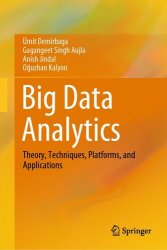 Название: Big Data Analytics: Theory, Techniques, Platforms, and Applications Название: Big Data Analytics: Theory, Techniques, Platforms, and Applications
Автор: Ümit Demirbaga, Gagangeet Singh Aujla, Anish Jindal
Издательство: Springer
Год: 2024
Страниц: 299
Язык: английский
Формат: pdf (true), epub
Размер: 39.8 MB
This book introduces readers to Big Data analytics. It covers the background to and the concepts of Big Data, Big Data analytics, and cloud computing, along with the process of setting up, configuring, and getting familiar with the Big Data analytics working environments in the first two chapters. The third chapter provides comprehensive information on Big Data processing systems - from installing these systems to implementing real-world data applications, along with the necessary codes. The next chapter dives into the details of Big Data storage technologies, including their types, essentiality, durability, and availability, and reveals their differences in their properties. The fifth and sixth chapters guide the reader through understanding, configuring, and performing the monitoring and debugging of Big Data systems and present the available commercial and open-source tools for this purpose. Chapter seven gives information about a trending Machine Learning, Bayesian network: a probabilistic graphical model, by presenting a real-world probabilistic application to understand causal, complex, and hidden relationships for diagnosis and forecasting in a scalable manner for Big Data. Special sections throughout the eighth chapter present different case studies and applications to help the readers to develop their Big Data analytics skills using various Big Data analytics frameworks.
The revolutionary potential of Big Data analytics has become a key component of strategic efforts for organisations globally in the ever-expanding digital landscape. Opportunities and difficulties arise from the sheer amount and diversity of data collected as the globe grows more linked. Big Data analytics emerges as the compass that leads decision-makers through the complexities of this data-rich terrain. Big Data analytics stimulates innovation and advances Artificial Intelligence, Machine Learning, and predictive modelling in addition to its function in revealing insights. This book acts as a bridge to this ever-changing world, guiding readers through the fundamental ideas and innovative uses that shape the field of Big Data analytics.
This collaborative endeavour, authored by experts in the field, serves as your comprehensive guide by offering a multifaceted exploration of Big Data analytics. Tailored to the reader’s unique role, expertise, and aspirations in the dynamic landscape of information technology, each chapter is crafted by a specialised contributor, which provides in-depth insights and expertise on specific aspects of the subject matter. This book is divided into 12 chapters. Chapter 1 establishes the groundwork by elucidating the essential properties of big data analytics, which explores the diverse range of techniques and provides an overview of the subsequent chapters. Chapter 2 provides a comprehensive guide to understanding big data, unravelling its definition, characteristics, the renowned 5 Vs, challenges, and future directions. Transitioning seamlessly, Chap. 3 introduces the realm of big data analytics that delves into the pivotal role big data analytics plays in risk management, cost reduction, data-driven decision-making, and product development. As the narrative unfolds, Chap. 4 extends the discussion to the intersection of big data and cloud computing by offering a historical backdrop and elucidating cloud computing units. Chapter 5 immerses the reader in the expansive landscape of big data analytics platforms. The chapter dissects the components of systems by delving into the main characteristics and desired properties. It also provides practical case studies through real-world applications. Navigating further, Chap. 6 addresses the critical aspect of big data storage solutions, which explores traditional systems, such as relational databases and data warehouses, and presents contemporary solutions and cloud storage.
Chapter 7 focuses on the pivotal realm of Big Data monitoring. Understanding the nuances of proactive and reactive monitoring, readers explore the monitoring components. The chapter concludes by acquainting readers with a spectrum of monitoring tools. As the reader ventures into Chap. 8, the book unfolds the intricate world of debugging Big Data systems. Acknowledging real-world performance problems, the chapter outlines systematic debugging steps and addresses common issues by providing a comprehensive guide to root cause analysis. Closing the narrative, Chap. 9 explores the synergy between machine learning and Big Data analytics. Diving into supervised and unsupervised Machine Learning, readers gain insights into challenges, preprocessing techniques, and popular algorithms. The chapter paints a holistic picture of the role Machine Learning plays in extracting meaningful patterns and predictions from massive datasets. Exploring the diverse applications of big data analytics across various sectors unveils a tapestry of innovation and strategic advancements. Chapter 10 delves into real-world case studies and applications that underscore the transformative impact of big data analytics, where each case study unveils the intricate interplay between big data analytics and sector-specific challenges. The examination of big data analytics for smart grids is expanded in Chap. 11, which also explains the intricacies of smart grids and illustrates how big data analytics is essential to improving their functionality. Finally, Chap. 12 delves into bioinformatics, which explores the intersection of big data and genomics. From understanding the challenges posed by Big Data in bioinformatics to examining frameworks for handling big genomic data, this section provides a holistic view of Big Data analytics in bioinformatics and a detailed case study in genomic medicine.
Скачать Big Data Analytics: Theory, Techniques, Platforms, and Applications
|